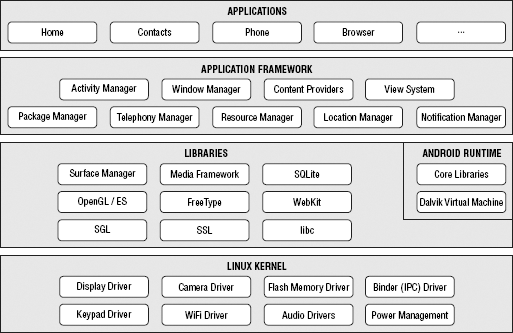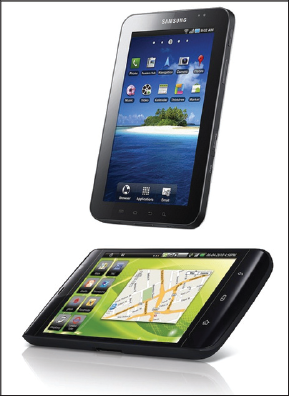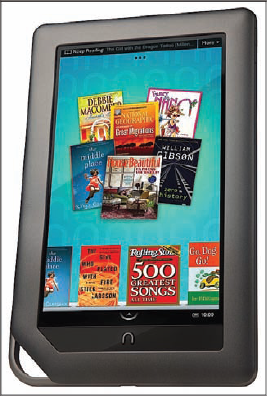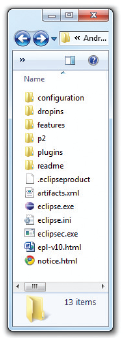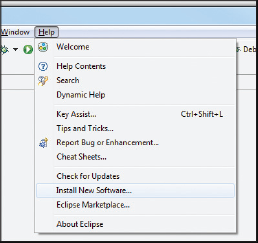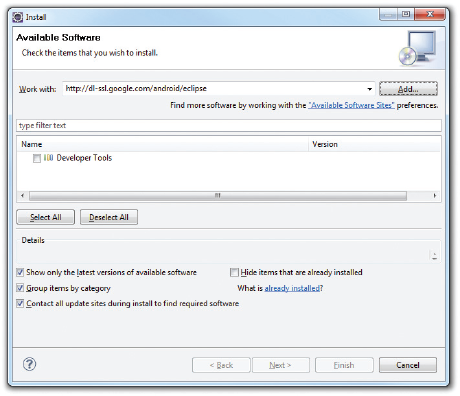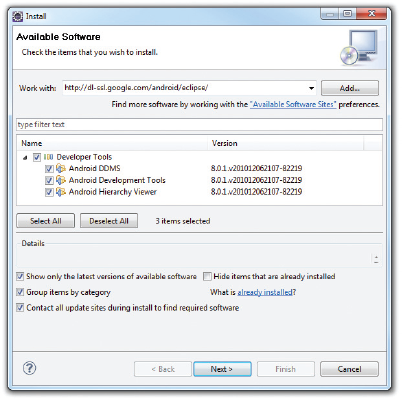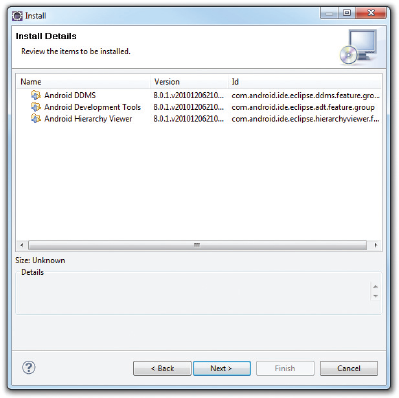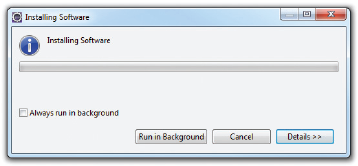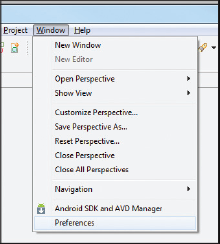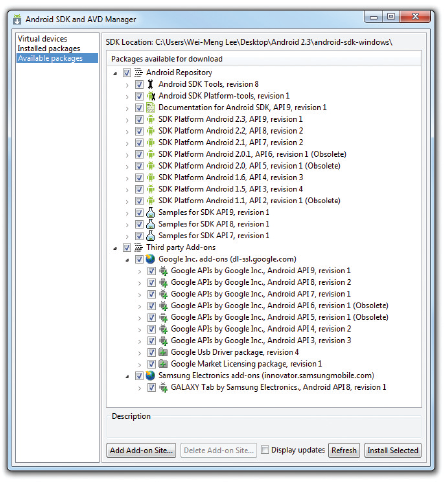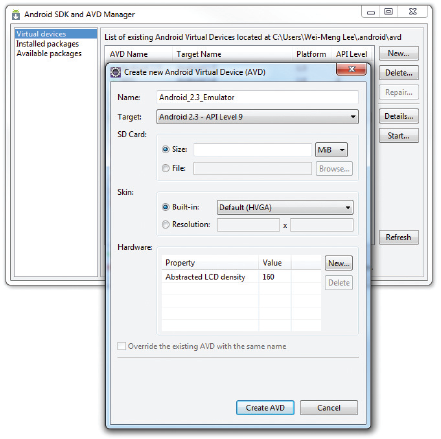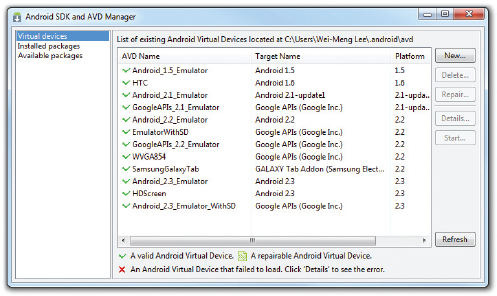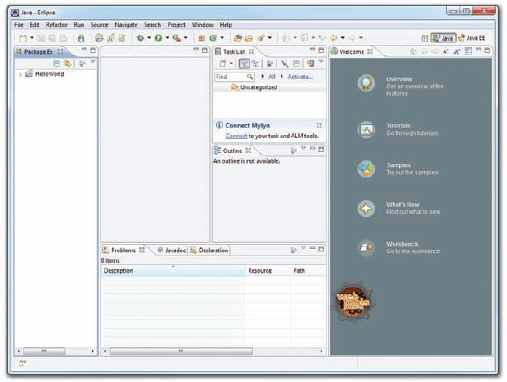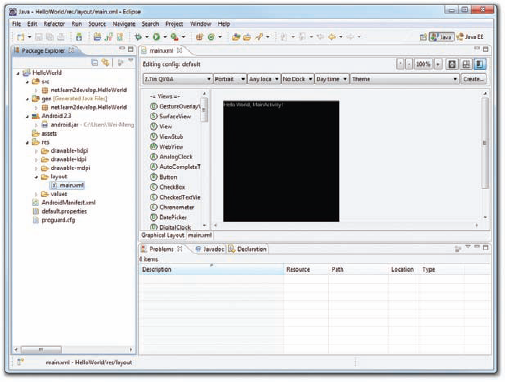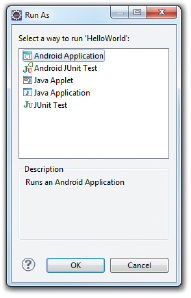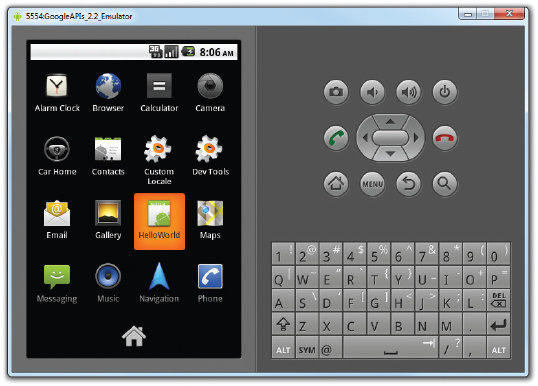WHAT YOU WILL LEARN IN THIS CHAPTER
What is Android?
Android versions and its feature set
The Android architecture
The various Android devices on the market
The Android Market application store
How to obtain the tools and SDK for developing Android applications
How to develop your first Android application
Welcome! The fact that you are holding this book in your hands (or are reading it on your latest mobile device) signifies that you are interested in learning how to write applications for the Android platform — and there's no better time to do this than now! The mobile application market is exploding, and recent market research shows that Android has overtaken iPhone to occupy the second position in the U.S. smartphone market. The first place honor currently goes to Research In Motion (RIM), with Apple's iPhone taking third place. By the time you read this, chances are good that Android may have become the number one smartphone platform in the U.S., and that you may even be reading this on one of the latest Android devices.
What propelled this relatively unknown operating system, which Google bought in 2005, to its popular status today? And what features does it offer? In this chapter you will learn what Android is, and what makes it so compelling to both developers and device manufacturers alike. You will also get started with developing your first Android application, and learn how to obtain all the necessary tools and set them up. By the end of this chapter, you will be equipped with the basic knowledge you need to explore more sophisticated techniques and tricks for developing your next killer Android application.
Android is a mobile operating system that is based on a modified version of Linux. It was originally developed by a startup of the same name, Android, Inc. In 2005, as part of its strategy to enter the mobile space, Google purchased Android and took over its development work (as well as its development team).
Google wanted Android to be open and free; hence, most of the Android code was released under the open-source Apache License, which means that anyone who wants to use Android can do so by downloading the full Android source code. Moreover, vendors (typically hardware manufacturers) can add their own proprietary extensions to Android and customize Android to differentiate their products from others. This simple development model makes Android very attractive and has thus piqued the interest of many vendors. This has been especially true for companies affected by the phenomenon of Apple's iPhone, a hugely successful product that revolutionized the smartphone industry. Such companies include Motorola and Sony Ericsson, which for many years have been developing their own mobile operating systems. When the iPhone was launched, many of these manufacturers had to scramble to find new ways of revitalizing their products. These manufacturers see Android as a solution — they will continue to design their own hardware and use Android as the operating system that powers it.
The main advantage of adopting Android is that it offers a unified approach to application development. Developers need only develop for Android, and their applications should be able to run on numerous different devices, as long as the devices are powered using Android. In the world of smartphones, applications are the most important part of the success chain. Device manufacturers therefore see Android as their best hope to challenge the onslaught of the iPhone, which already commands a large base of applications.
Android has gone through quite a number of updates since its first release. Table 1-1 shows the various versions of Android and their codenames.
As Android is open source and freely available to manufacturers for customization, there are no fixed hardware and software configurations. However, Android itself supports the following features:
Storage — Uses SQLite, a lightweight relational database, for data storage. Chapter 6 discusses data storage in more detail.
Connectivity — Supports GSM/EDGE, IDEN, CDMA, EV-DO, UMTS, Bluetooth (includes A2DP and AVRCP), WiFi, LTE, and WiMAX. Chapter 8 discusses networking in more detail.
Messaging — Supports both SMS and MMS. Chapter 8 discusses messaging in more detail.
Web browser — Based on the open-source WebKit, together with Chrome's V8 JavaScript engine
Media support — Includes support for the following media: H.263, H.264 (in 3GP or MP4 container), MPEG-4 SP, AMR, AMR-WB (in 3GP container), AAC, HE-AAC (in MP4 or 3GP container), MP3, MIDI, Ogg Vorbis, WAV, JPEG, PNG, GIF, and BMP
Hardware support — Accelerometer Sensor, Camera, Digital Compass, Proximity Sensor, and GPS
Tethering — Supports sharing of Internet connections as a wired/wireless hotspot
In order to understand how Android works, take a look at Figure 1-1, which shows the various layers that make up the Android operating system (OS).
The Android OS is roughly divided into five sections in four main layers:
Linux kernel — This is the kernel on which Android is based. This layer contains all the low-level device drivers for the various hardware components of an Android device.
Libraries — These contain all the code that provides the main features of an Android OS. For example, the SQLite library provides database support so that an application can use it for data storage. The WebKit library provides functionalities for web browsing.
Android runtime — At the same layer as the libraries, the Android runtime provides a set of core libraries that enable developers to write Android apps using the Java programming language. The Android runtime also includes the Dalvik virtual machine, which enables every Android application to run in its own process, with its own instance of the Dalvik virtual machine (Android applications are compiled into the Dalvik executables). Dalvik is a specialized virtual machine designed specifically for Android and optimized for battery-powered mobile devices with limited memory and CPU.
Application framework — Exposes the various capabilities of the Android OS to application developers so that they can make use of them in their applications.
Applications — At this top layer, you will find applications that ship with the Android device (such as Phone, Contacts, Browser, etc.), as well as applications that you download and install from the Android Market. Any applications that you write are located at this layer.
Android devices come in all shapes and sizes. As of late November 2010, the Android OS can be seen powering the following types of devices:
Chances are good that you own at least one of the preceding devices. Figure 1-2 shows (clockwise) the Samsung Galaxy S, the HTC Desire HD, and the LG Optimus One smartphones.
Another popular category of devices that manufacturers are rushing out is the tablet. Tablet sizes typically start at seven inches, measured diagonally. Figure 1-3 shows the Samsung Galaxy Tab and the Dell Streak, which is a five-inch phone tablet.
Besides smartphones and tablets, Android is also beginning to appear in dedicated devices, such as e-book readers. Figure 1-4 shows the Barnes and Noble's NOOKcolor, which is a color e-Book reader running the Android OS.
In addition to these popular mobile devices, Android is also slowly finding its way into your living room. People of Lava, a Swedish company, has developed an Android-based TV, call the Scandinavia Android TV (see Figure 1-5).
Google has also ventured into a proprietary smart TV platform based on Android and co-developed with companies such as Intel, Sony, and Logitech. Figure 1-6 shows Sony's Google TV.
As mentioned earlier, one of the main factors determining the success of a smartphone platform is the applications that support it. It is clear from the success of the iPhone that applications play a very vital role in determining whether a new platform swims or sinks. In addition, making these applications accessible to the general user is extremely important.
As such, in August 2008, Google announced the Android Market, an online application store for Android devices, and made it available to users in October 2008. Using the Market application that is preinstalled on their Android device, users can simply download third-party applications directly onto their devices. Both paid and free applications are supported on the Android Market, though paid applications are available only to users in certain countries due to legal issues.
Similarly, in some countries, users can buy paid applications from the Android Market, but developers cannot sell in that country. As an example, at the time of writing, users in India can buy apps from the Android Market, but developers in India cannot sell apps on the Android Market. The reverse may also be true; for example, users in South Korea cannot buy apps, but developers in South Korea can sell apps on the Android Market.
Chapter 11 discusses more about the Android Market and how you can sell your own applications in it.
Now that you know what Android is and its feature set, you are probably anxious to get your hands dirty and start writing some applications! Before you write your first app, however, you need to download the required tools and SDKs.
For Android development, you can use a Mac, a Windows PC, or a Linux machine. All the tools needed are free and can be downloaded from the Web. Most of the examples provided in this book should work fine with the Android emulator, with the exception of a few examples that require access to the hardware. For this book, I will be using a Windows 7 computer to demonstrate all the code samples. If you are using a Mac or Linux computer, the screenshots should look similar; some minor differences may be present, but you should be able to follow along without problems.
So, let the fun begin!
The first step towards developing any applications is obtaining the integrated development environment (IDE). In the case of Android, the recommended IDE is Eclipse, a multi-language software development environment featuring an extensible plug-in system. It can be used to develop various types of applications, using languages such as Java, Ada, C, C++, COBOL, Python, etc.
For Android development, you should download the Eclipse IDE for Java EE Developers (www.eclipse.org/downloads/packages/eclipse-ide-java-ee-developers/heliossr1). Six editions are available: Windows (32 and 64-bit), Mac OS X (Cocoa 32 and 64), and Linux (32 and 64-bit). Simply select the relevant one for your operating system. All the examples in this book were tested using the 32-bit version of Eclipse for Windows.
Once the Eclipse IDE is downloaded, unzip its content (the eclipse folder) into a folder, say C:Android. Figure 1-7 shows the content of the eclipse folder.
The next important piece of software you need to download is, of course, the Android SDK. The Android SDK contains a debugger, libraries, an emulator, documentation, sample code, and tutorials.
You can download the Android SDK from http://developer.android.com/sdk/index.html.
Once the SDK is downloaded, unzip its content (the android-sdk-windows folder) into the C:Android folder, or whatever name you have given to the folder you just created.
The Android Development Tools (ADT) plug-in for Eclipse is an extension to the Eclipse IDE that supports the creation and debugging of Android applications. Using the ADT, you will be able to do the following in Eclipse:
To install the ADT, first launch Eclipse by double-clicking on the eclipse.exe file located in the eclipse folder.
When Eclipse is first started, you will be prompted for a folder to use as your workspace. In Eclipse, a workspace is a folder where you store all your projects. Take the default suggested and click OK.
Once Eclipse is up and running, select the Help
In the Install window that appears, type http://dl-ssl.google.com/android/eclipse in the text box (see Figure 1-9) and click Add....
After a while, you will see the Developer Tools item appear in the middle of the window (see Figure 1-10). Expand it, and it will reveal its content: Android DDMS, Android Development Tools, and Android Hierarchy Viewer. Check all of them and click Next.
When you see the installation details, as shown in Figure 1-11, click Next.
You will be asked to review the licenses for the tools. Check the option to accept the license agreements (see Figure 1-12). Click Finish to continue.
Eclipse will now proceed to download the tools from the Internet and install them (see Figure 1-13). This will take some time, so be patient.
Note
If you have any problems downloading the ADT, check out Google's help at http://developer.android.com/sdk/eclipse-adt.html#installing.
Once the ADT is installed, you will be prompted to restart Eclipse. After doing so, go to Window
In the Preferences window that appears, select Android. You will see an error message saying that the SDK has not been set up (see Figure 1-15). Click OK to dismiss it.
Enter the location of the Android SDK folder. In this example, it would be C:Androidandroid-sdk-windows. Click OK.
The next step is to create AVD to be used for testing your Android applications. AVD stands for Android Virtual Devices. An AVD is an emulator instance that enables you to model an actual device. Each AVD consists of a hardware profile, a mapping to a system image, as well as emulated storage, such as a secure digital (SD) card.
You can create as many AVDs as you want in order to test your applications with several different configurations. This testing is important to confirm the behavior of your application when it is run on different devices with varying capabilities.
Note
Appendix B will discuss some of the capabilities of the Android Emulator.
To create an AVD, go to Windows
Select the Available packages option in the left pane and expand the package name shown in the right pane. Figure 1-16 shows the various packages available for you to create AVDs to emulate the different versions of an Android device.
Check the relevant tools, documentation, and platforms you need for your project.
Once you have selected the items you want, click the Install Selected button to download them. Because it takes a while to download from Google's server, it is a good idea to download only whatever you need immediately, and download the rest when you have more time.
Note
For a start, you should at least select the latest SDK platform. At the time of writing, the latest SDK platform is SDK Platform Android 2.3, API 9, revision 1.
Each version of the Android OS is identified by an API level number. For example, Android 2.3 is level 9 (API 9), while Android 2.2 is level 8 (API 8), and so on. For each level, two platforms are available. For example, level 9 offers the following:
SDK Platform Android 2.3
Google APIs by Google Inc.
The key difference between the two is that the Google APIs platform contains the Google Maps library. Therefore, if the application you are writing requires Google Maps, you need to create an AVD using the Google APIs platform (more on this in Chapter 9, "Location Based Services."
Click the Virtual Devices item in the left pane of the window. Then click the New... button located in the right pane of the window.
In the Create new Android Virtual Device (AVD) window, enter the items as shown in Figure 1-17. Click the Create AVD button when you are done.
In this case, you have created an AVD (put simply, an Android emulator) that emulates an Android device running version 2.3 of the OS. In addition to what you have created, you also have the option to emulate the device with an SD card and different screen densities and resolutions.
Note
Appendix B explains how to emulate the different types of Android devices.
It is preferable to create a few AVDs with different API levels so that your application can be tested on different devices. The example shown in Figure 1-18 shows the many AVDs created to test your applications on a wide variety of different Android platforms.
With all the tools and the SDK downloaded and installed, it is now time to start your engine! As in all programming books, the first example uses the ubiquitous Hello World application. This will enable you to have a detailed look at the various components that make up an Android project.
So, without any further ado, let's dive straight in!
Now that you have created your first Hello World Android application, it is time to dissect the innards of the Android project and examine all the parts that make everything work.
First, note the various files that make up an Android project in the Package Explorer in Eclipse (see Figure 1-30).
The various folders and their files are as follows:
src— Contains the .javasource files for your project. In this example, there is one file,MainActivity.java. TheMainActivity.javafile is the source file for your activity. You will write the code for your application in this file.Android 2.3library — This item contains one file,android.jar, which contains all the class libraries needed for an Android application.gen— Contains theR.javafile, a compiler-generated file that references all the resources found in your project. You should not modify this file.assets— This folder contains all the assets used by your application, such as HTML, text files, databases, etc.res— This folder contains all the resources used in your application. It also contains a few other subfolders:drawable-<resolution>, layout, andvalues. Chapter 3 talks more about how you can support devices with different screen resolutions and densities.AndroidManifest.xml— This is the manifest file for your Android application. Here you specify the permissions needed by your application, as well as other features (such as intent-filters, receivers, etc.). Chapter 2 discusses the use of theAndroidManifest.xmlfile in more details.
The main.xml file defines the user interface for your activity. Observe the following in bold:
<TextView
android:layout_width="fill_parent"
android:layout_height="wrap_content"
android:text="@string/hello" />The @string in this case refers to the strings.xml file located in the res/values folder. Hence, @string/hello refers to the hello string defined in the strings.xml file, which is "Hello World, MainActivity!":
<?xml version="1.0" encoding="utf-8"?>
<resources>
<string name="hello">Hello World, MainActivity!</string>
<string name="app_name">HelloWorld</string>
</resources>It is recommended that you store all the string constants in your application in this strings.xml file and reference these strings using the @string identifier. That way, if you ever need to localize your application to another language, all you need to do is replace the strings stored in the strings.xml file with the targeted language and recompile your application.
Observe the content of the AndroidManifest.xml file:
<?xml version="1.0" encoding="utf-8"?>
<manifest xmlns:android="http://schemas.android.com/apk/res/android"
package="net.learn2develop.HelloWorld"
android:versionCode="1"
android:versionName="1.0">
<application android:icon="@drawable/icon" android:label="@string/app_name">
<activity android:name=".MainActivity"
android:label="@string/app_name">
<intent-filter>
<action android:name="android.intent.action.MAIN" />
<category android:name="android.intent.category.LAUNCHER" />
</intent-filter>
</activity>
</application>
<uses-sdk android:minSdkVersion="9" />
</manifest>The AndroidManifest.xml file contains detailed information about the application:
It defines the package name of the application as
net.learn2develop.HelloWorld.The version code of the application is 1. This value is used to identify the version number of your application. It can be used to programmatically determine whether an application needs to be upgraded.
The version name of the application is 1.0. This string value is mainly used for display to the user. You should use the format: <major>.<minor>.<point> for this value.
The application uses the image named
icon.pnglocated in thedrawablefolder.The name of this application is the string named
app_namedefined in thestrings.xmlfile.There is one activity in the application represented by the
MainActivity.javafile. The label displayed for this activity is the same as the application name.Within the definition for this activity, there is an element named
<intent-filter>:The action for the intent filter is named
android.intent.action.MAINto indicate that this activity serves as the entry point for the application.The category for the intent-filter is named
android.intent.category.LAUNCHERto indicate that the application can be launched from the device's Launcher icon. Chapter 2 discusses intents in more details.
Finally, the
android:minSdkVersionattribute of the<uses-sdk>element specifies the minimum version of the OS on which the application will run.
As you add more files and folders to your project, Eclipse will automatically generate the content of R.java, which at the moment contains the following:
package net.learn2develop.HelloWorld;
public final class R {
public static final class attr {
}
public static final class drawable {
public static final int icon=0x7f020000;
}
public static final class layout {
public static final int main=0x7f030000;
}
public static final class string {
public static final int app_name=0x7f040001;
public static final int hello=0x7f040000;
}
}You are not supposed to modify the content of the R.java file; Eclipse automatically generates the content for you when you modify your project.
Note
If you delete R.java manually, Eclipse will regenerate it for you immediately. Note that in order for Eclipse to generate the R.java file for you, the project must not contain any errors. If you realize that Eclipse has not regenerated R.java after you have deleted it, check your project again. The code may contain syntax errors, or your XML files (such as AndroidManifest.xml, main.xml, etc.) may not be well-formed.
Finally, the code that connects the activity to the UI (main.xml) is the setContentView() method, which is in the MainActivity.java file:
package net.learn2develop.HelloWorld;
import android.app.Activity;
import android.os.Bundle;
public class MainActivity extends Activity {
/** Called when the activity is first created. */
@Override
public void onCreate(Bundle savedInstanceState) {
super.onCreate(savedInstanceState);
setContentView(R.layout.main);
}
}Here, R.layout.main refers to the main.xml file located in the res/layout folder. As you add additional XML files to the res/layout folder, the filenames will automatically be generated in the R.java file. The onCreate() method is one of many methods that are fired when an activity is loaded. Chapter 2 discusses the life cycle of an activity in more detail.
This chapter has provided a brief overview of Android, and highlighted some of its capabilities. If you have followed the sections on downloading the tools and SDK, you should now have a working system — one that is capable of developing more interesting Android applications other than the Hello World application. In the next chapter, you will learn about the concepts of activities and intents, and the very important roles they play in Android.

